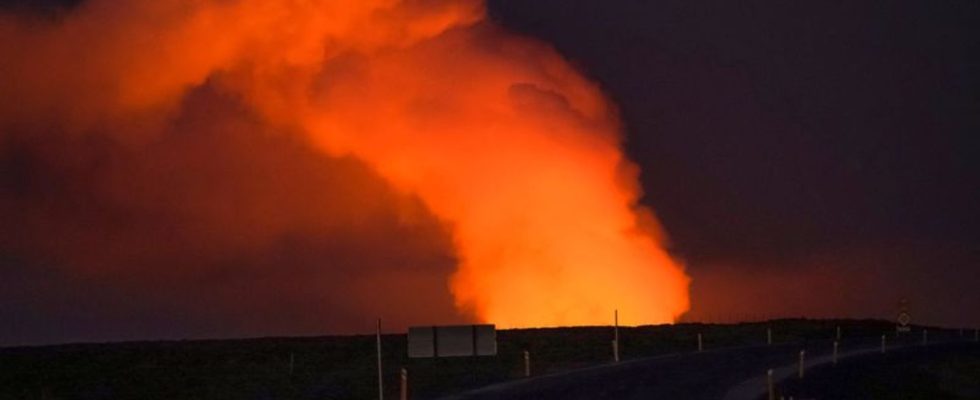eruption
Volcanic eruption in Iceland – What shouldn’t happen
View of the gas cloud illuminated by the lava of the erupting volcano. photo
© Marco Di Marco/AP
Even for the volcano-experienced Icelanders, the scenes that took place in the evacuated town of Grindavík were dramatic: for the first time in decades, lava masses destroyed several houses on the island.
The shock is deep after the dramatic one Volcanic eruption in southwest Iceland. For the first time in half a century, lava has also engulfed and destroyed homes on the North Atlantic island. “The thing we all hoped would not happen has happened,” Icelandic President Gudni Th. Jóhannesson stated in a speech to the nation. On Monday the situation near the coastal town of Grindavík calmed down somewhat.
The renewed volcanic eruption on a peninsula southwest of Reykjavík began on Sunday morning. It had been announced in the hours before with an intense series of earthquakes, then glowing red lava emerged from a hundreds-meter-long fissure in the earth. In the midday hours another chasm opened up – right on the northern outskirts of Grindavík. The lava masses reached the outskirts of the town, at least three houses burst into flames and were completely destroyed.
Now Iceland has experienced crises thanks to eruptions like the one on the Eyjafjallajökull volcanic glacier in 2010. But this eruption is the first since 1973 to affect housing: in his speech on Sunday evening, President Jóhannesson recalled the volcanic eruption on the island of Heimaey, in which lava and ash destroyed numerous houses.
President Jóhannesson encourages his compatriots
To encourage his compatriots, he quoted then-President Kristján Eldjárn, who said: “It will take less than this catastrophe for Icelanders to realize that this small nation is more like a big family that knows what Whatever happens to one of us, happens to all of us.”
The 4,000-inhabitant town of Grindavík is located on the Reykjanes Peninsula in southwest Iceland, where volcanic eruptions have occurred repeatedly in recent years. This is the second eruption in the area in four weeks and the fifth since 2021. Grindavík was already affected by the eruption in mid-December – although not by the lava, but by several earthquakes, which caused deep cracks in roads and other damage caused. The place was already evacuated at that time for security reasons.
On Monday afternoon, live footage from the RÚV radio station showed that red-hot lava continued to bubble out of the earth, although nowhere near as intensely as at the beginning of the eruption. According to RÚV, volcanic activity appeared to continue to decrease. However, a natural disaster expert, Lovísa Mjöll Gudmundsdóttir, told the broadcaster that it was difficult to assess how the situation in the area would develop. She made it clear: the eruption is not over yet.
No danger to human life
According to the Icelandic government, there was no risk to human life because Grindavík was evacuated again in good time the night before the eruption. Air traffic to and from Iceland is therefore not affected.
According to RÚV, Iceland’s Prime Minister Katrín Jakobsdóttir said after a cabinet meeting on Monday that the government is working to find a solution to the housing situation of the evacuated residents of Grindavík. The Blue Lagoon, a geothermal bath near Grindavík that is particularly popular with Icelandic tourists, has been closed until Tuesday.

